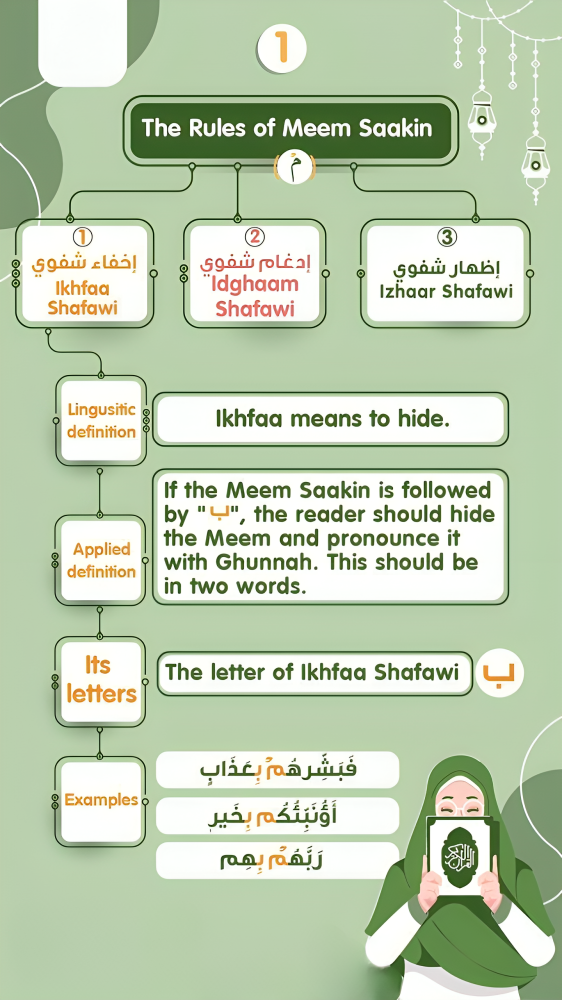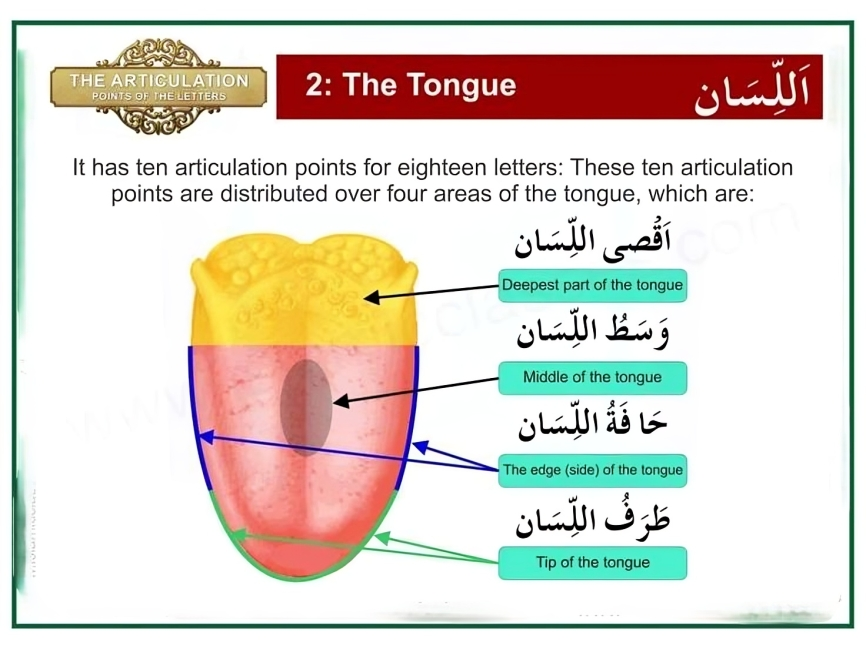Understanding Meem Saakin and Meem Mushaddad in Tajweed
In the study of Tajweed, the correct pronunciation of Meem Saakin (مْ) and Meem Mushaddad (مّ) is essential for accurate Quran recitation. This lesson provides a comprehensive guide to these important Tajweed rules, explaining how to apply Ghunna and the key rules of Idghaam Shafwi, Ikhfaa Shafwi, and Izhaar Shafwi, with examples from the Quran.
What is Meem Saakin?
Meem Saakin (مْ) refers to the letter Meem (م) with a Sukoon ( ْ ) on it. When a letter has a Sukoon, it means the letter is pronounced without any vowel sound. The sound of Meem Saakin stops at the Meem without elongation or modulation.
What is Meem Mushaddad?
Meem Mushaddad (مّ) refers to the letter Meem (م) with Tashdeed ( ّ ) on it, indicating that the letter is doubled. The pronunciation of Meem Mushaddad is emphasized, holding the sound slightly longer than usual.
When you recite Meem Mushaddad, you must apply Ghunna, which means producing a nasal sound through the nose. Ghunna lasts for the duration it takes to pronounce one Alif (roughly two counts).
The Importance of Ghunna in Meem Mushaddad
Ghunna is a nasal sound produced from the nose. It is mandatory to apply Ghunna on Meem Mushaddad. This nasal sound is important in making the recitation of Meem with Tashdeed (Mushaddad) distinct and proper.
- Example from the Quran:
عَمَّ
This word in Surah An-Naba (78:1) contains Meem Mushaddad, where Ghunna is applied.
Three Rules for Meem Saakin in Tajweed
When reciting Meem Saakin, there are three key rules that apply, depending on which letter follows Meem. These rules are:
- Idghaam Shafwi (Merging of Meem)
- Ikhfaa Shafwi (Concealment of Meem)
- Izhaar Shafwi (Clear Pronunciation of Meem)
Let’s break down each of these rules:
1. Idghaam Shafwi (Merging of Meem with Meem)
Idghaam means merging. In this case, if Meem Saakin is followed by another Meem, the two Meems are merged, and only one Meem is pronounced with Ghunna (a nasal sound).
This rule is known as Idghaam Shafwi because it relates to letters pronounced using the lips, specifically the Meem sound.
- Example from the Quran:
إِنَّكُمْ مُّسْلِمُونَ (Quran 49:14)
In this example, Meem Saakin is followed by another Meem. As a result, the two Meems merge, and you pronounce it with Ghunna.
2. Ikhfaa Shafwi (Concealment of Meem)
Ikhfaa means to hide or conceal. If Meem Saakin is followed by the letter Ba (ب), the sound of Meem Saakin will be concealed and pronounced through the nose with Ghunna. This is referred to as Ikhfaa Shafwi.
- Example from the Quran:
يَقُولُ بِاللَّهِ (Quran 3:167)
Here, Meem Saakin is followed by the letter Ba, so it is pronounced with Ghunna through the nose, applying Ikhfaa Shafwi.
3. Izhaar Shafwi (Clear Pronunciation of Meem)
Izhaar means to pronounce clearly. If Meem Saakin is followed by any letter other than Meem or Ba, it is pronounced clearly without Ghunna. This is known as Izhaar Shafwi.
- Example from the Quran:
هُمْ فِيهَا (Quran 16:97)
In this example, Meem Saakin is followed by a letter other than Meem or Ba, so the Meem is pronounced clearly, without any nasal sound.
Why Is It Called Shafwi?
The term Shafwi relates to the lips because the letter Meem is pronounced using the two lips. All the rules for Meem Saakin and Meem Mushaddad involve articulation from the lips, making it important to understand how these rules work to perfect your Quran recitation.
Conclusion
Mastering the rules of Meem Saakin and Meem Mushaddad is critical for proper Quranic recitation. By applying the correct Tajweed rules—Idghaam Shafwi, Ikhfaa Shafwi, and Izhaar Shafwi—you can ensure your recitation is accurate and in line with the teachings of Tajweed. Practice these rules regularly with examples from the Quran to improve your fluency and pronunciation.




